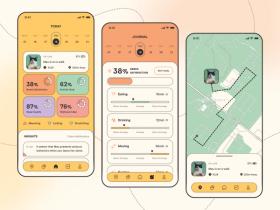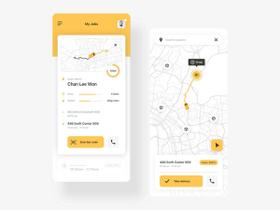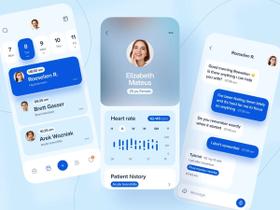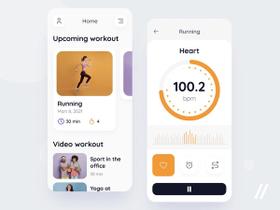IoT Application Development Guide for 2025
Published: February 18, 2025
32 min read
In this article, you'll learn:
1
📋 7 Steps to Create IoT Applications
2
👨💻 Our Expertise in IoT App Development
3
🔍 Top Things to Pay Attention to in IoT Application Development
4
🔴 Potential Pitfalls in IoT App Development & How to Avoid Them
5
⚙️ Top Functionality of an IoT Software
6
🗂️ Industries With High Demand for IoT Applications
7
💰 What Affects IoT Application Development Costs?
8
💡 Takeaways
The Internet of Things (IoT) industry is expanding rapidly. Its market is currently valued at $439 billion and is expected to grow fivefold by 2034 (according to Precedence Research findings). As smart technology becomes more integrated into everyday life and industries, IoT application development offers you a unique opportunity to enhance efficiency, automation, and user experiences.
From smart homes and connected fitness equipment to industrial automation and AI-powered agriculture, IoT is reshaping how devices interact and operate. However, the real power of connectivity lies not just in the devices themselves but in the software that controls them. A well-built IoT app can bridge the gap between hardware and seamless user interaction, unlocking new levels of functionality and connectivity.
Did you know that choosing the wrong backend can double your IoT app costs in the long run? Or that poor data handling can crash your entire system? In this guide, we’ll walk you through key decisions that make or break IoT applications.
Navigating the IoT app development process can be complex. To help you succeed, we've prepared this step-by-step guide that can give answers to your questions. Let’s go!
📋 7 Steps to Create IoT Applications
Developing IoT applications requires a structured, strategic approach to ensure security, scalability, and seamless functionality. With our hands-on expertise in this field, we have refined a proven framework that streamlines the development process while addressing key challenges.
Step 1: Define Your Objective and Scope
Before diving into development, clearly define what your application aims to achieve. Consider:
- Use Case: Connected fitness equipment, smart home automation, healthcare monitoring, etc.
- Target Audience: Who will use your application, and what problem does it solve?
- Key Functionalities: What devices will it connect to, and what info will it process?
Why This Matters: A well-defined objective and compatibility with existing hardware ensures that every decision — from backend infrastructure to UI design — is aligned with your goals.
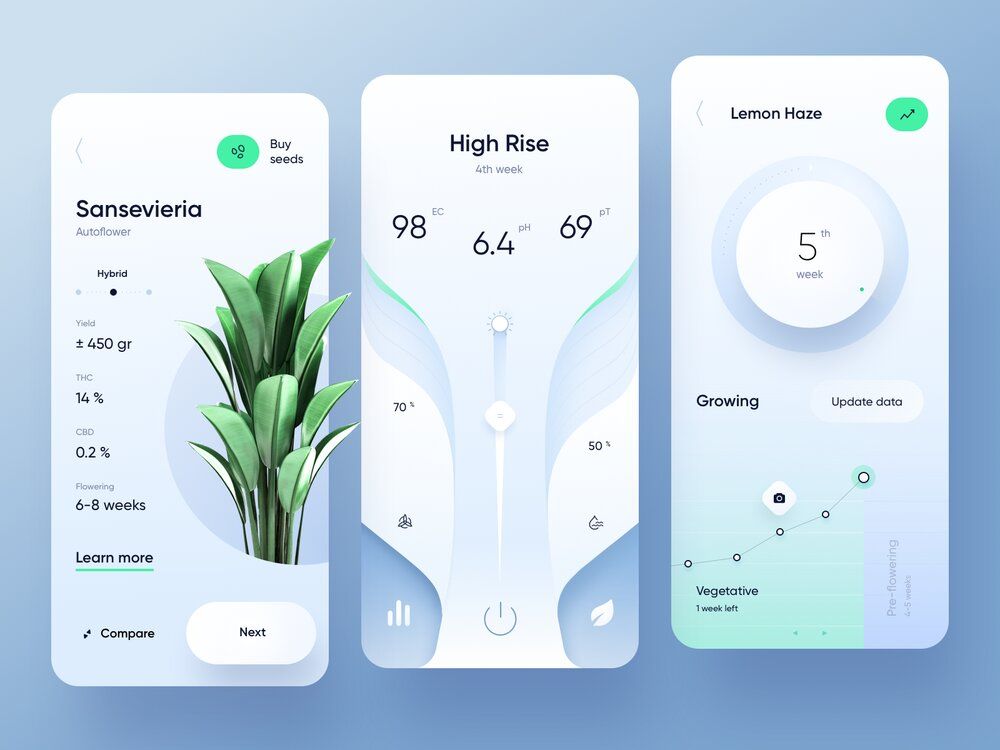
Example of Internet of Things application for plant watering (image by Sèrgi Mi)
Step 2: Establish Secure Data Collection
Your app will handle sensitive info and you should make security a top priority in developing IoT applications, especially when dealing with the Internet of Things in medical fields where patient data protection is critical. Key strategies include:
- End-to-End Encryption: Protect information during transmission and storage.
- Device Authentication: Use secure API keys or public-key infrastructure (PKI).
- Tamper-Resistant Devices: Prevent unauthorized access or statistics manipulation.
🛠 Recommended Tech Stack: Utilize platforms like Telit, which offers modules, platforms, and services for secure info collection, ensuring end-to-end IoT security.
Why This Matters: Strong security ensures info integrity, regulatory compliance, and user trust.
Step 3: Implement Scalable Data Streaming & Storage
IoT applications generate large volumes of real-time information. To handle this efficiently:
- Use Stream Processing: Apache Kafka, MQTT, or Amazon Kinesis for real-time data flow.
- Cloud Storage: Amazon S3 or Microsoft Azure IoT for scalable storage.
- Edge Computing: Process statistics locally before sending them to the cloud to reduce latency.
Why This Matters: Without a high-performance streaming and storage system, your application may suffer from delays, crashes, or excessive cloud costs.
Step 4: Develop a Scalable Backend with IoT Platforms
Your backend is responsible for data processing, analytics, and device management, especially in use cases like EV charging mobile app development or BMS software development. To build a robust and scalable backend, leveraging IoT apps development platforms can significantly streamline the process.
These platforms offer ready-to-use tools and services that cover:
✅ Secure device-to-cloud communication
✅ Protocol management for seamless connectivity
✅ Authentication and security features
✅ Data collection, storage, and real-time analytics
📌 Many platforms also support IoT remote update features, enabling developers to push firmware updates remotely to enhance security, fix bugs, and introduce new functionalities seamlessly.
Choosing the Right IoT Platform
Instead of developing everything from scratch, IoT platforms provide pre-built infrastructure that simplifies backend development. Some of the most widely used options include:
- Google Cloud IoT – Scalable cloud solutions with integrated AI/ML capabilities.
- Arduino IoT Cloud – Best for prototyping and small-scale IoT solutions.
- Azure IoT Suite – A comprehensive set of tools for connecting, managing, and analyzing IoT details.
- AWS IoT Core – Robust infrastructure with built-in security and flexible deployment options.
- IBM Watson IoT – AI-powered insights and seamless device-server communication.
- Oracle IoT – Cloud-based platform with strong visualization and security features.
- KAA IoT – Open-source IoT platform with customizable features.
Using an IoT platform, you can reduce initial costs and develop IoT application faster. However, many platforms operate on a subscription or usage-based model, which might lead to increasing expenses over time.
Backend Architecture Considerations
To ensure scalability and long-term performance, focus on:
- Microservices Architecture: Break down backend functionality into smaller, manageable services for better scalability.
- API Integration: Enable seamless communication between devices, cloud storage, and analytics tools.
Why This Matters: A well-structured backend ensures that connected devices operate smoothlywithout overloading your system. Whether you choose a cloud-based or custom-built solution, it should align with your project's long-term goals and growth strategy.
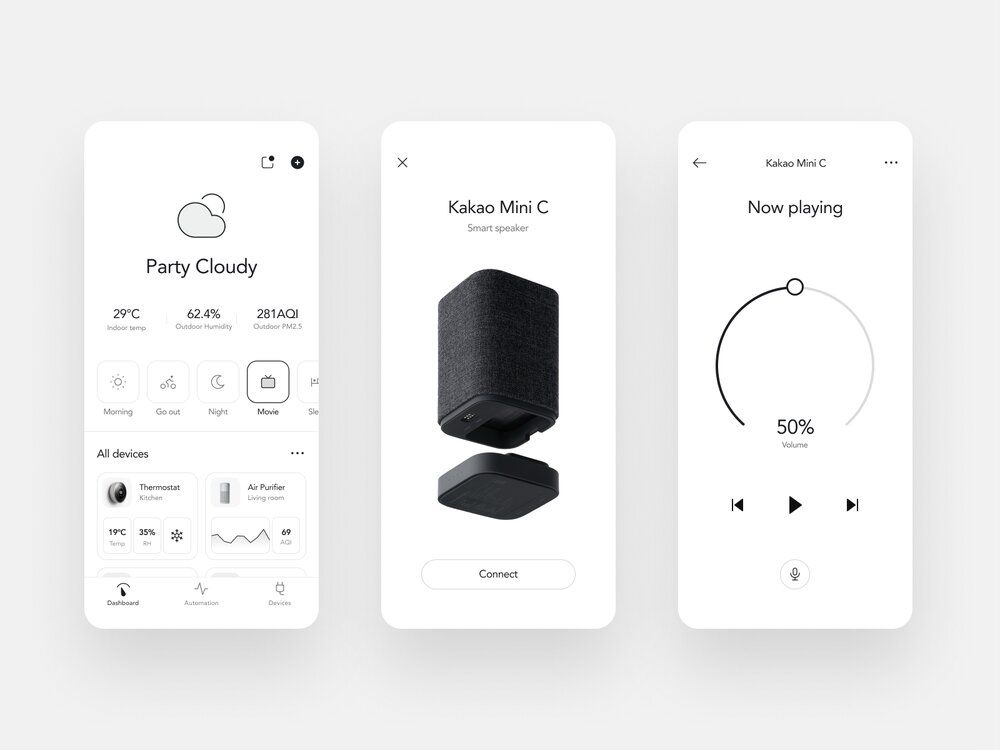
You can build IoT applications using a platform, including cloud-based solutions (image by quan ❖)
Step 5: Design an Intuitive Frontend
Your IoT mobile app should be user-friendly and provide meaningful insights. When considering how to make IoT app, focus on key design principles:
- Clear Statistics Visualization: Graphs, real-time status updates, and alerts.
- Cross-Platform Compatibility: Ensure smooth operation across iOS, Android, and the web.
- Low Latency UI: React Native, Flutter, or Kotlin for fast and responsive experiences.
Why This Matters: A well-designed frontend enhances user engagement and simplifies IoT info interpretation.
Step 6: Test and Iterate
Rigorous testing ensures performance, security, and reliability across different devices. Test for:
- Functional Testing: Verify sensors, data collection, and device interactions.
- Security Testing: Penetration testing to prevent unauthorized access.
- Load Testing: Simulate high-traffic conditions to ensure system stability.
🛠 Recommended Tech Stack: For testing, use platforms like Mocha for JavaScript applications, and for device simulation, the Azure IoT Device Telemetry Simulation tool.
Why This Matters: IoT applications fail without proper testing, leading to security breaches, hardware failures, or poor user experience.
Step 7: Deploy, Maintain, and Scale Your IoT Application
When building IoT applications, ensure seamless deployment, maintenance, and long-term scalability by:
- Using Containerization & Orchestration: Docker + Kubernetes.
- Implementing Continuous Monitoring: Update the software and continuously improve the application based on user feedback.
- Optimizing for Growth: Automatically scale cloud resources as user demand increases.
🛠 Recommended Tech Stack: Google Cloud's Bigtable offers robust and scalable solutions that can grow with your user base, while AWS Auto Scaling can dynamically adjust resources based on usage.
Why This Matters: Without a solid deployment and scaling plan, your application may suffer from downtime, performance bottlenecks, or excessive operational costs.
Following this seven-step framework, you can efficiently develop a secure, scalable, and high-performing MVP or full-scale IoT application. From defining objectives to deployment and scaling, each step ensures seamless functionality and a great user experience.
Need help bringing your IoT app idea to life?
Let’s talk!
👨💻 Our Expertise in IoT App Development
As an IoT software development company, Stormotion has helped businesses bridge the gap between hardware and software, ensuring seamless interactions between users and their connected devices.
Our experience spans various industries, from smart batteries and fitness equipment to e-scooters, tackling BLE connectivity, real-time data monitoring, OTA updates, and more.
Let’s take a look at some of our recent IoT application development projects where we addressed IoT challenges into scalable solutions.
Norsk Guardian
Norsk Guardian reached out to us to build an advanced Bluetooth-enabled battery companion app for Norsk’s lithium-ion batteries, ensuring safety in open water, ice fishing, and kayaking.
Our Solution:
- Developed a custom Bluetooth Low Energy (BLE) communication protocol for real-time battery monitoring.
- Designed an alert system to notify users of potential battery failures before they happen.
- Conducted hands-on testing with real batteries to fine-tune data retrieval and charging indicators.
- Built a React Native app with an intuitive, minimalist UI, making technical details easy to understand.
💡 Outcome: Norsk users now enjoy safer trips with a proactive battery health monitoring system, reducing the risk of unexpected power failures.

The Norsk Guardian app displays key battery status information and notifies users of potential failures (image by Stormotion)
SportPlus
SportPlus approached us to develop an IoT application, ensuring seamless communication with multiple workout machines.
Our Solution:
- Built a generic protocol handler with BLE integration to unify device communication.
- Developed a custom CMS to allow SportPlus to create and manage workout content for users.
- Designed an intuitive real-time workout tracking feature with clear progress milestones.
💡 Outcome: Users get a personalized, data-driven workout experience, while SportPlus can easily update and expand their fitness equipment.

SportPlus allows fitness enthusiasts to connect their workout equipment to its mobile app (image by Stormotion)
If you want to learn more about IoT in the fitness industry and how to integrate workout equipment with mobile apps, check out our comprehensive guide 👇
STEPR
STEPR needed to develop an Android-based console application that integrates with its 27-inch display of the stair-climbing machine while overcoming Android security restrictions and enabling real-time control.
Our Solution:
- Reverse-engineered Android’s hidden APIs to enable system-level operations.
- Integrated a custom Serial protocol to ensure stable communication with the fitness machine.
- Designed a user-friendly UI with large, interactive elements for easy navigation during workouts.
- Added OTA updates, real-time workout metrics, and entertainment features (Netflix, Spotify, YouTube).
💡 Outcome: A fully interactive, feature-rich console that enhances user engagement and makes workouts more immersive.

STEPR is a stair-climbing machine managed by a built-in console (image by Stormotion)
Egret
Egret contacted us to solve OTA update delays and BLE inconsistencies after the mobile app migrated from Native to React Native.
Our Solution:
- Developed a custom native Bluetooth module to speed up OTA updates.
- Reverse-engineered protocol handlers to identify inefficiencies and improve communication speed.
- Created a universal BLE handler to ensure compatibility across all Egret e-scooter models.
💡 Outcome: Faster updates, smoother BLE connectivity, and an overall more reliable e-scooter app experience.

Egret allows riders to connect their e-scooters to the companion app (image by Stormotion)
Across all our IoT projects, we:
✅ Request real devices to test and optimize features in real-world conditions.
✅ Develop custom BLE & Serial communication protocols to ensure seamless data exchange.
✅ Prioritize UI/UX design to simplify complex technical interactions for users.
✅ Implement OTA updates for continuous feature improvements without hardware replacements.
Want to develop a custom IoT app that meets your needs?
Contact Us
🔍 Top Things to Pay Attention to in IoT Application Development
Developing an IoT application, including a companion app, is a complex process with many technical nuances. To ensure a smooth development journey and avoid common pitfalls, focus on these key factors.
Firmware Updating
Firmware acts as the bridge between hardware and software, controlling communication between:
- Hardware boards
- Edge computing
- Sensors
The Internet of Things software development speed of your IoT application is directly influenced by whether your firmware is ready-to-use or still in development:
- Ready-to-use firmware allows for a smoother development process, with potential slowdowns only caused by minor bugs that can be resolved relatively quickly.
- Early-stage firmware can significantly delay development, as debugging, testing, and synchronizing firmware and application updates become more complex.
Thus, we highly recommend choosing hardware with well-developed and tested firmware. This ensures:
✅ Faster time-to-market
✅ Fewer integration challenges
✅ More efficient testing and debugging
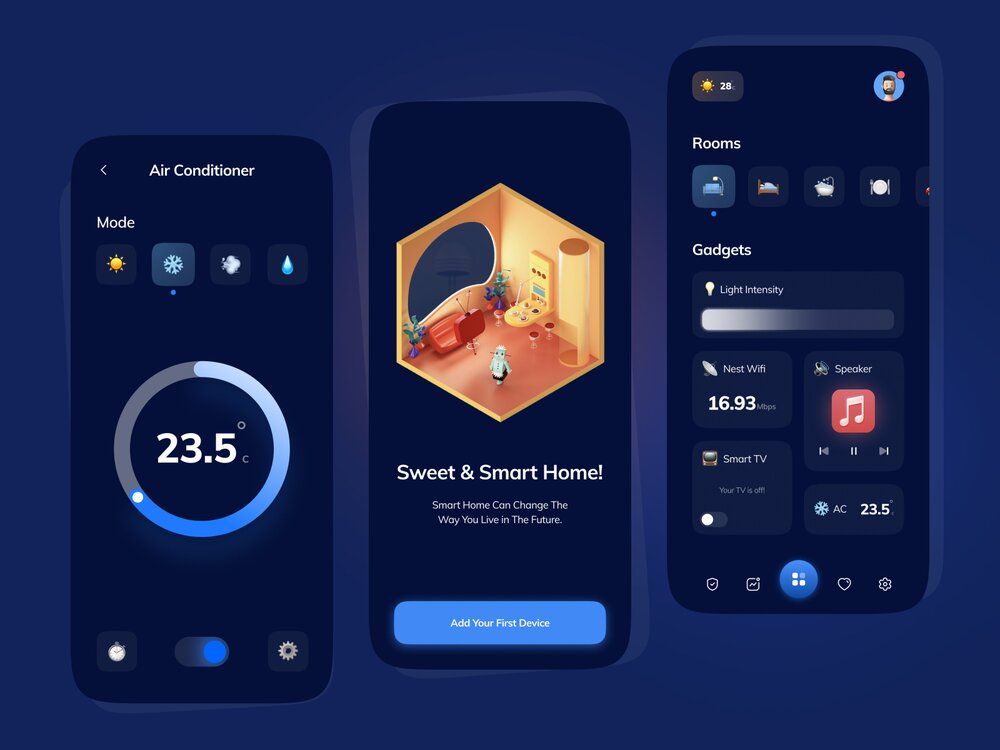
Firmware is a crucial component when making IoT applications for smart devices (image by Mostafa Esmaeili)
One crucial aspect to consider is Over-the-Air (OTA) updates. These allow remote firmware updates without manual intervention, improving security and user experience.
However, mandatory updates can sometimes disrupt user interactions. Imagine a smart lock refusing to open because it requires an update — frustrating, right? To enhance the user experience:
✅ Make updates optional when possible
✅ Notify users in advance about upcoming updates
✅ Allow users to schedule updates at their convenience
Third-Party Integrations
If your IoT solution needs to work with external devices or AI-powered assistants like Google Home & Alexa, you'll need to focus on these aspects of Internet of Things application development.
# 1: Data Acquisition Module
This module collects physical signals (e.g., temperature, motion, light) from IoT sensors and converts them into digital info. Key considerations include:
- Which signals need to be measured (motion, temperature, etc.)
- The number of sensors required
- The speed and accuracy needed for information collection
Once you have answers to these questions, you’ll determine the requirements for this module.
# 2: Data Processing Module
This module handles:
- Data analytics & processing
- Local or cloud data storage
- Real-time decision-making
When setting up this module, you should answer several questions to understand how to make an IoT app:
- How much info will be processed? The info flow could range from a few kilobytes to gigabytes per day, depending on the number of sensors and the frequency of stats updates. This factor will affect the choice of processing platforms (cloud-based vs. edge computing) and your overall infrastructure.
- Will you store data locally or in the cloud? This decision has profound implications for costs, scalability, and security. Local storage offers speed but has limited capacity. Cloud storage offers scalability but may introduce latency.
- How long should the device function offline? In some use cases, devices need to operate without a connection to the internet. For example, if you're building an IoT-enabled security camera that must record even when the network is down. Hence, you should ensure sufficient local storage and processing capacity during IoT applications development.
- Edge computing vs. cloud computing: Depending on the use case, you may opt for edge computing to process info closer to the device, which minimizes latency and bandwidth consumption. Alternatively, cloud computing is suitable for large-scale storage and more complex analytics.
Your decision will impact the performance and scalability of your IoT solution, so it’s crucial to get it right from the start.

Processing is an important part of IoT app development for all types of devices, from smart homes to medical systems (image by Stas Koval 🇺🇦)
# 3: Communications Module
The Communications Module is the backbone of any IoT device, enabling it to exchange information with other devices, storage, and platforms. When developing software for your IoT device, you should choose the right connectivity options based on your specific requirements.
Key aspects to consider:
1. Data Exchange Needs:
- Ensure smooth communication between your IoT device, sensors, gateways, and external services.
- Consider the power consumption, range, bandwidth, and latency that best suit your application.
2. The Right IoT Connectivity: The connectivity protocol determines how your device communicates with other systems. When selecting a protocol to create IoT app, you need to consider various factors such as:
- Range: How far will the device need to communicate? For instance, Wi-Fi offers a shorter range than LPWAN or cellular options.
- Power Consumption: Battery-powered devices require low-power protocols like Z-Wave or ZigBee.
- Speed: Depending on the data transfer needs (e.g., real-time or periodic updates), you might opt for protocols like Ethernet for high-speed connectivity or Android BLE connection for short-range, fast communication.
- Industry Requirements: Some industries might have specific standards for connectivity. For example, LPWAN is ideal for agriculture or urban development due to its extended range, while Bluetooth is often used in consumer applications.
By understanding these aspects and protocols, you can select the most appropriate connectivity solution and develop an IoT application with reliable and efficient communication.
📌 For more details on the different IoT protocols and how to choose the right one for your solution, check out our article about connectivity in IoT.
#4: Testing with Real Devices or Prototypes
Testing your IoT application with real devices or IoT prototypes is crucial to ensure that everything works in the real world, not just in theory:
- Device Durability: Test the hardware in real-life conditions (e.g., temperature, humidity) to ensure it functions in various environments.
- Network Reliability: Ensure the device works across different network conditions and stays connected.
- Application Interaction: Make sure the app interacts smoothly with the hardware for a seamless user experience.
- Security Testing: Conduct penetration tests to identify vulnerabilities and ensure user information is protected.
By testing in real conditions, you ensure the device will meet the reliability, security, and performance expectations of your users.
How to Integrate an IoT App with Third-Party Devices like Google Home & Alexa?
When such virtual AI assistants entered the market, it became truly disrupted. Integrating IoT with voice-controlled assistants like Google Home or Amazon Alexa enhances the user experience with hands-free control.
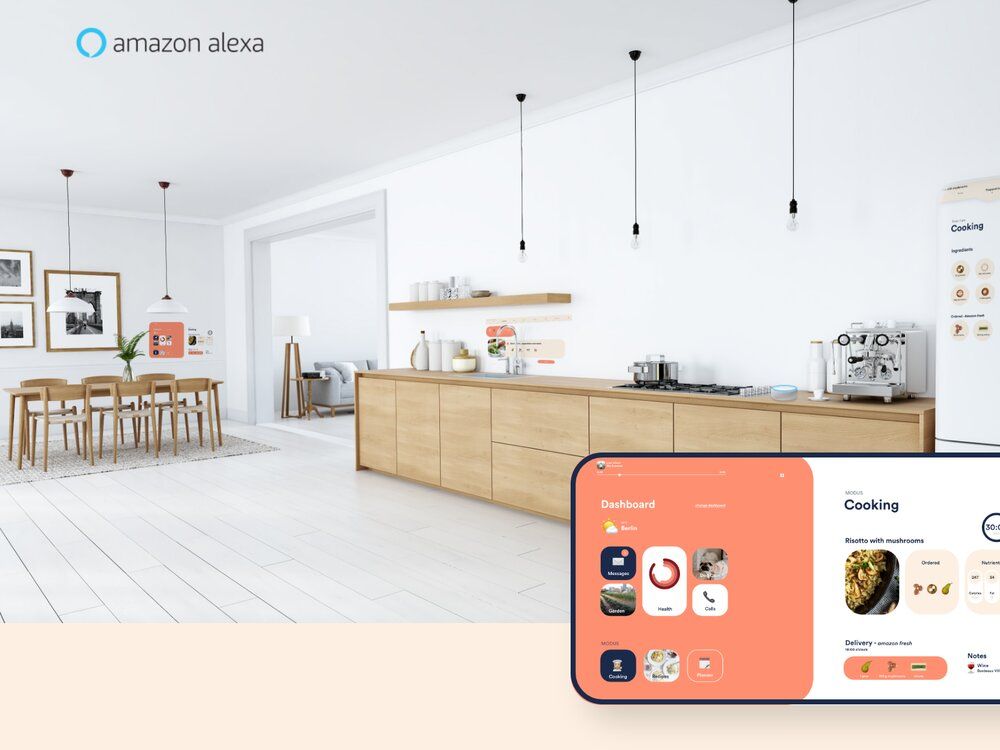
Example of an AI assistant system to integrate with a smartphone (image by Patricia Reiners)
Here’s how to build IoT applications with a virtual assistant integration:
- Use APIs for Integration: Google and Amazon provide APIs to create "Actions" (Google) or "Skills" (Alexa) that enable voice commands.
- Host on the Right Server: Google’s system can run on any server, but Alexa requires AWS Lambda for hosting.
- Ensure Security & Compliance: Ensure your integrations meet data privacy and security standards, and submit for platform approval, which can take up to a week.
- Leverage Existing Commands: Both platforms offer pre-built commands that may meet your needs, saving development time.
Integrating smart assistants can offer users a more convenient and seamless interaction with your IoT device.
Developing a robust IoT application requires careful consideration — from ensuring smooth firmware updates and integrating third-party devices to optimizing info acquisition, processing, and communications, and rigorously testing your solution in real-world conditions. If you address these key areas, you can build a secure, scalable IoT system that delivers a seamless user experience.
🔴 Potential Pitfalls in IoT App Development & How to Avoid Them
During app building for your IoT device, you should be aware of possible challenges that, if not properly addressed, could negatively impact costs, user experience quality, or development speed.
So, let’s briefly review the main pitfalls you may encounter during Internet of Things application development.
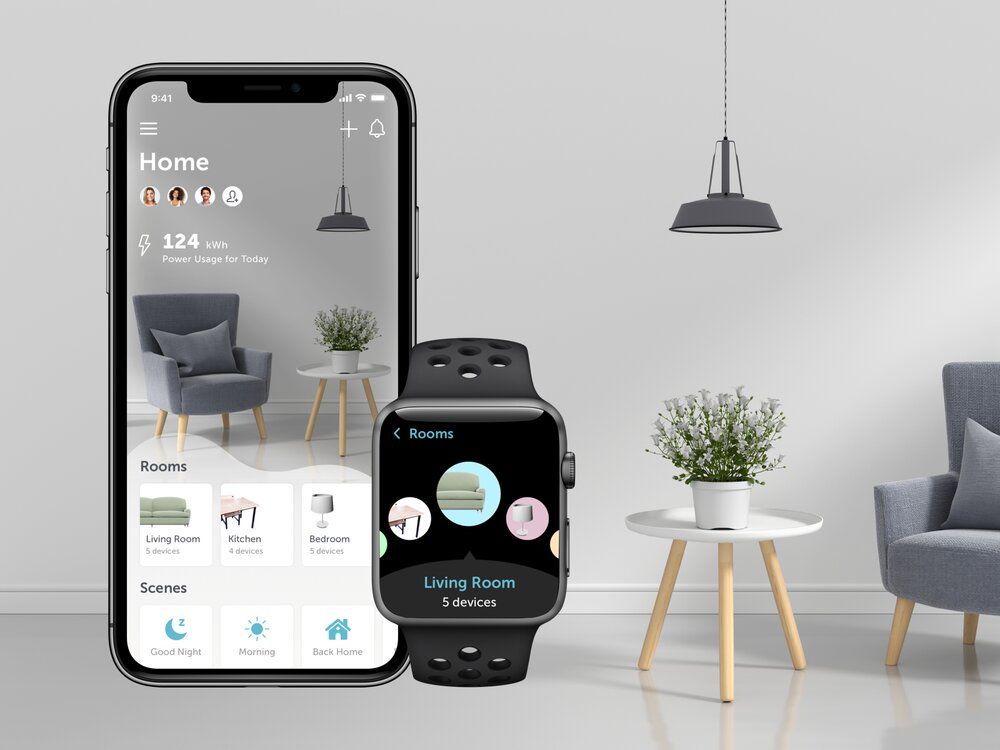
An Internet of Things (IoT) app needs to communicate with other connected IoT components (image by Simona Vorlova)
# 1: Security
Security remains one of the biggest challenges in the IoT industry, especially in sensitive sectors like IoT in healthcare and the development of apps to track mental health. A major issue is the lack of standardized regulations that developers and engineers must follow to ensure a system is 100% reliable.
Additionally, the high number of connected devices, such as sensors, increases vulnerability, making it easier for hackers to exploit security breaches.
If you want to know how to create IoT applications with enhanced security, consider these key measures:
- Security by design. This approach focuses on preventing breaches in an IoT security system rather than fixing them after they occur. It involves regular testing, authentication safeguards, and implementing the best cybersecurity practices.
- Regular updates. Security improvements often come through trial and error. Update as soon as you identify potential vulnerabilities or areas for improvement.
- Robust security protocols. Use protocols like HTTPS and TLS to protect information transmission.
- Multi-factor authentication (MFA). Strengthen access security with biometric authentication (fingerprints, facial and voice recognition), end-to-end encryption (ensuring only the sender and recipient can access messages), personal security questions, email/phone number verification, and regularly updated complex passwords.
Developing an IoT application can be complex, but with the right expertise, you can build a secure and scalable solution.
Contact Us
# 2: Inconsistency
If your app is designed to control multiple devices within a single interface, you may encounter inconsistencies with devices from other brands.
For example, if a user buys your smart toaster but chooses a fridge from another company, you can’t guarantee the app will be able to control both devices. This can negatively impact your service quality and reputation.
The root of this issue is the lack of unified standardization. Different companies use varied APIs, protocols, and security features.
The trickiest part? There’s not much you can do to fully resolve it. A possible workaround is to allow third-party integrations via their APIs, but whether this is feasible during IoT apps development depends on your specific use case.
# 3: Recovery Mode
Adding a recovery mode to your IoT application can be beneficial, allowing users to restore lost information from the cloud or other storage options.
This feature must be planned before development because implementing it requires access to the device’s bootloader — something that’s significantly easier to integrate during the manufacturing stage.
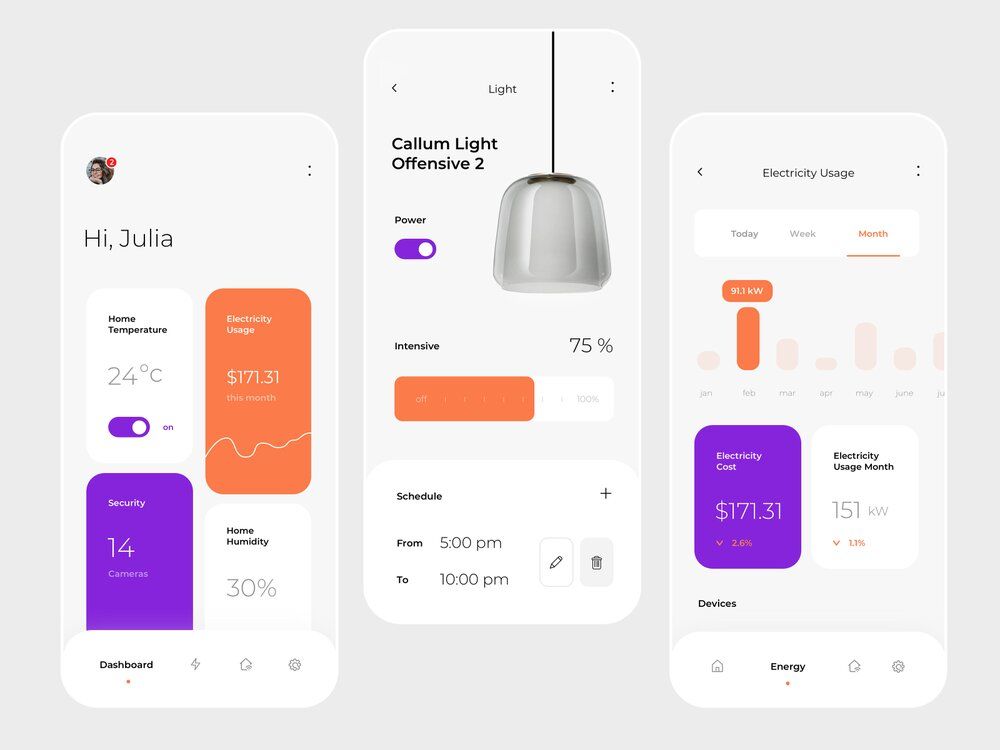
You can build a recovery mode into apps for the Internet of Things (image by Patryk Polak)
# 4: Quality Assurance
Every IoT firmware update — especially when you build a smart home app — should undergo rigorous testing to assess its impact on the application. This includes:
- Fixing bugs
- Evaluating app behavior
- Ensuring proper synchronization with the cloud or other storage
However, the key challenge here is that simulations alone are not enough. For instance, our development team tests updates manually or on real devices to ensure accurate results.
# 5: Issues and Disruptions while Connecting Software and Devices
As you learn more about how to develop IoT apps — a task often facilitated by mobile app development services — you should understand how to integrate hardware and software, a process that comes with unique challenges. Here are the most critical issues developers and users may encounter.
Integration Issues | Explanation |
|---|---|
Hardware Compatibility | Compatibility isn’t just about technical specifications. It also includes environmental resilience and upgradeability. For instance, outdoor scanners/sensors must withstand extreme weather conditions, while industrial IoT devices should be designed for long-term durability. |
Network Reliability | Network protocol choice impacts energy efficiency. Zigbee and Z-Wave, for example, are popular in smart home applications due to their IoT low power consumption and mesh networking capabilities, which enhance coverage and reliability. |
Data Management | Efficient info processing and storage are crucial. Edge computing — processing data closer to the source — can reduce latency and optimize bandwidth use, improving real-time responsiveness. |
Security Threats | IoT security must be proactive, incorporating end-to-end encryption, regular firmware updates, and secure boot processes. AI and ML can also help detect and mitigate security threats in real time. |
Scalability Concerns | Scaling an IoT system isn’t just about handling more devices. It’s also about managing rising costs for information storage and processing. A cost-effective scaling strategy should balance performance and budget constraints. |
Technological Inconsistency | Different companies use varied APIs and protocols, leading to interoperability challenges. Professionals should use standardized APIs to improve device compatibility and streamline integration. |
Software Complexity | IoT software should follow a modular design for independent development, testing, and maintenance of different functionalities. This approach simplifies updates and long-term support. |
Cloud Dependencies | Relying solely on cloud services can be risky. A hybrid approach, combining cloud-based and local processing, ensures the system remains functional even if cloud services experience downtime. |
Interoperability Issues | Protocols like MQTT and CoAP help IoT devices communicate across different manufacturers. Adopting these standards improves cross-platform compatibility and streamlines device integration. |
Regulatory Compliance | IoT compliance is constantly evolving. Developers must implement a flexible compliance strategy that accommodates new privacy laws and industry-specific regulations over time. |
IoT application development requires careful planning to avoid costly pitfalls. To ensure efficiency and security, developers should:
- Implement robust security measures
- Ensure interoperability with standardized protocols
- Integrate recovery modes early in development
- Conduct real-world quality testing
- Address integration issues of software and hardware proactively
⚙️ Top Functionality of an IoT Software
In this section, we’ll explore the core components of IoT software — whether it’s a mobile app, web application, or dashboard — across different industries, including agriculture IoT.
Rather than just listing features, we’ll focus on key nuances and less obvious aspects that can impact functionality.
# 1: Data Collection
The backend of your IoT software handles data collection, and choosing the right strategy can save energy, resources, and costs. Your approach to how to build IoT applications should be based on:
- Frequency & Accuracy: Define the optimal accuracy level — higher precision isn’t always necessary. If a lower frequency still meets requirements, you can reduce info collection intervals, optimizing resource use.
- Time Sensitivity: If stats lose relevance over time, set a maximum time gap between measurements to ensure freshness while avoiding unnecessary info collection.
- Energy Consumption: Similar to frequency control, data collection should balance accuracy with energy efficiency, ensuring minimal power use without compromising quality.
- Privacy Considerations: To limit unnecessary info collection, introduce “noise” to prevent oversharing while remaining compliant with regulations.
# 2: Data Processing
Data processing is resource-intensive, so it’s crucial to prioritize what’s necessary to ensure the cost, energy, and time efficiency of IoT application development.
- Assess Data Volume: Process only essential information to keep the system running smoothly.
- Optimize Third-Party Services: If using external data processing solutions, review:
- Security risks and breach history
- Service agreements (many teams overlook vendor terms)
- Enable Real-Time Processing: This is critical for industries like agriculture, healthcare, weather forecasting, and smart security systems.
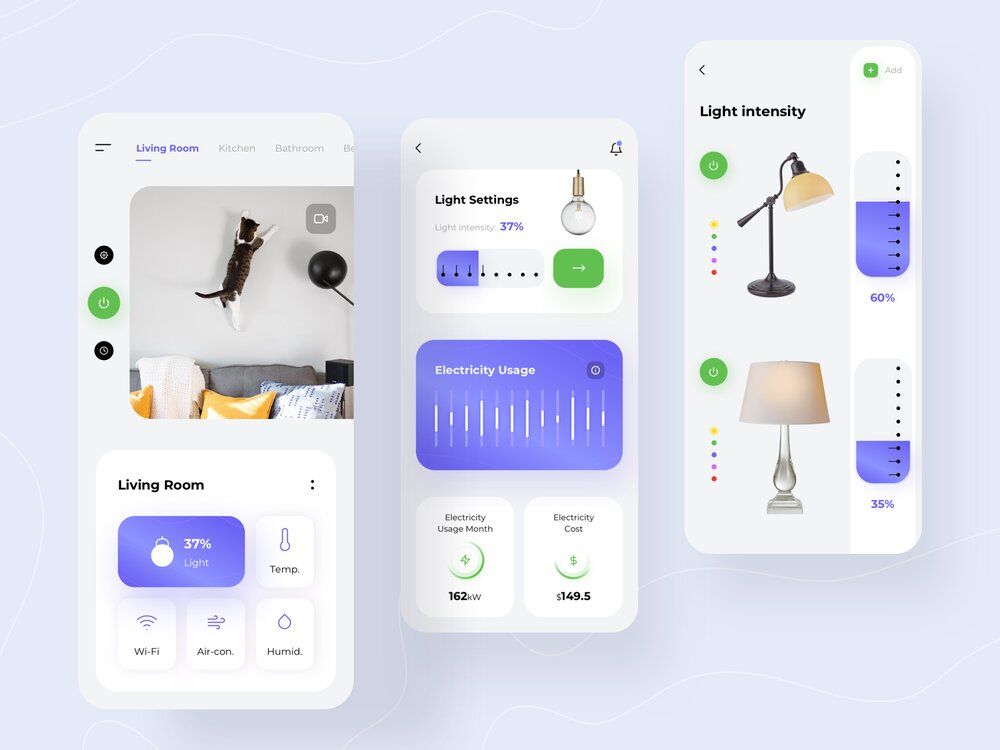
Dashboards and mobile apps for the Internet of Things should provide users with real-time statistics (image by Nadya Lazurenko)
# 3: Data Storage
IoT devices typically have limited storage, so external storage is essential. When considering how to make IoT applications and select a storage solution, keep the following in mind:
- Quick Data Retrieval: Ensure the system retrieves and processes information efficiently.
- Searchable & Filterable Data: Use timestamped indexing and filters to help users easily find relevant information.
- Exportability: Allow stats to be converted into multiple formats for analysis and comparison.
# 4: Data Analytics
Data analytics enables Internet of Things systems to function effectively by filtering raw stats and extracting meaningful insights for users. Before visualization, analytics should:
- Provide Real-Time Insights: Immediate stats interpretation helps users take action promptly when needed.
- Identify Trends & Patterns: Long-term analytics help users observe trends and make data-driven decisions.
- Generate Automated Recommendations: Analytics can offer actionable suggestions based on patterns.
- Enhance Personalization: Businesses can optimize marketing efforts with data-driven targeting and customization.
# 5: Data Visualization
To present analyzed statistics, during IoT applications development you should include:
- Visual Representation: Real-time dashboards, charts, sensor overviews, and tables.
- Historical Data: Easy access to past stats for comparison.
- Notifications: Alert users about new or critical stats.
- Actionable Alerts: Highlight urgent issues requiring immediate attention.
💡 Pro Tip:
- Use sound effects or flashing icons to make critical alerts stand out.
- Avoid clutter — allow users to select specific data variables instead of displaying multiple redundant graphs.
Example: Instead of separate charts for humidity across different fields, when you build IoT application provide a dropdown menu where users can select the field they want to monitor.
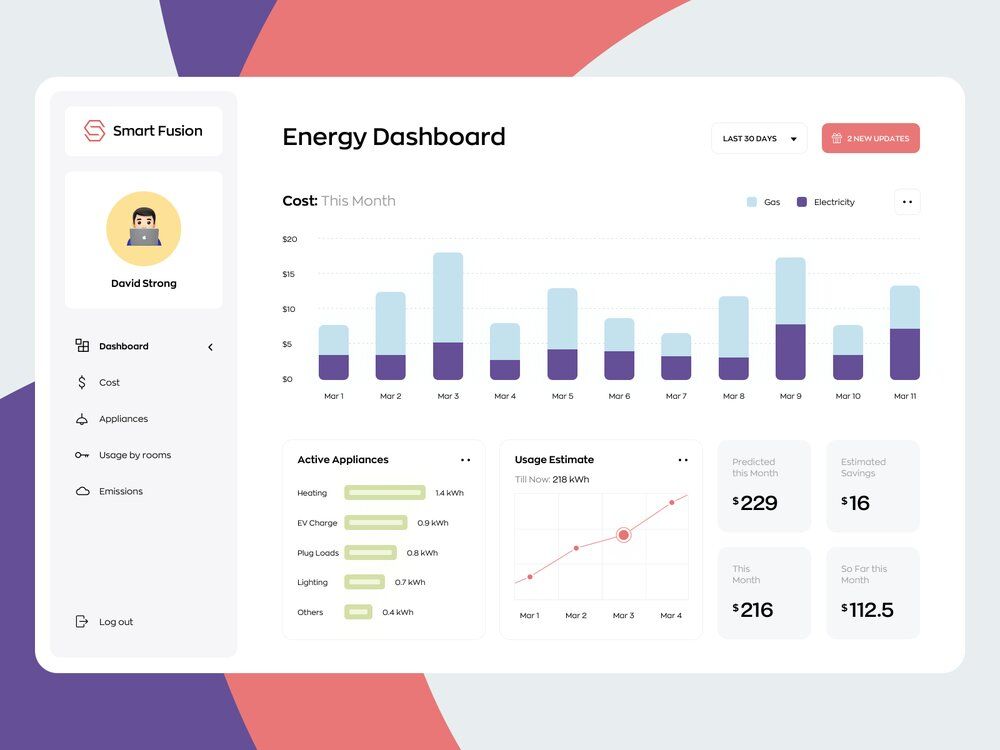
An example of a dashboard to consider when developing Internet of Things apps (image by Anton Mihalcov)
# 6: Device Management
Your Internet of Things system should allow users to control devices and their components efficiently. This includes:
- Provisioning & Authentication: Securely adding new devices to the system.
- Configuration & Control: Adjusting settings, turning devices on/off, modifying modes, and managing info transfer to the cloud.
- Monitoring & Diagnostics: Tracking performance, detecting issues, and running self-diagnostics.
- Software Updates & Maintenance: Enabling remote troubleshooting and firmware updates.
💡 Additional Features to Consider:
- Device Grouping & Hierarchy: Organize sensors within devices and group multiple devices into fleets.
- Advanced Search Functionality: Search by Device ID, Status (on/off, working/broken), or Type. It’s particularly useful for large-scale systems, such as hospitals or industrial setups.
Understanding how to create IoT app starts with a well-structured approach to its core functions.
- Data Collection: Optimize frequency, accuracy, energy efficiency, and privacy.
- Data Processing: Prioritize essential stats and ensure cost-effective, secure processing.
- Data Storage: Enable fast retrieval, searchability, and flexible formatting.
- Data Analytics: Provide real-time insights, trend detection, and automation.
- Data Visualization: Use intuitive, user-friendly dashboards with categorized alerts.
- Device Management: Implement comprehensive control, diagnostics, and search features.
🗂️ Industries With High Demand for IoT Applications
The Internet of Things has transformed multiple industries, including significant advancements in the IoT in manufacturing industry, reshaping the way businesses operate and how people interact with technology. Let’s explore some of the top industries where Internet of Things app development is in high demand.
Use Cases in Healthcare
IoT-powered smart devices integrated with app development for healthcare have revolutionized patient care, enabling doctors to monitor health conditions in real-time and take proactive measures. The use of smart wearables IoT, sensors, and connected medical equipment enhances patient safety, improves diagnostics, and supports preventive care.
Statista reports that there were 1.27 billion healthcare devices connected to IoT technologies worldwide in 2024. This number is expected to reach 2.88 billion in 2028.

During IoT app development, ensure that your mobile app is compatible with smart devices (image by Awsmd)
Examples of IoT Apps in Healthcare
The most prominent examples of Internet of Medical Things (IoMT) usage in healthcare are:
- Smartwatches & Wearables. Devices like the Apple Watch continuously track heart rates, detect irregularities, and even help prevent heart attacks by monitoring signs such as blood clot formation. Apple has also introduced an API that enables Parkinson’s disease monitoring, automatically tracking symptoms like tremors and dyskinesia.
- CenTrak RTLS (Real-Time Location System). This IoT-powered system optimizes hospital workflows by providing real-time location for staff, patients, and medical equipment, improving efficiency and patient experience.
Use Cases in Logistics
The Internet of Things in logistics goes beyond simple asset tracking. It enables real-time info collection and remote fleet management, optimizing energy use and reducing delays. IoT apps development with React Native BLE frameworks, integrated by skilled BLE app developers, can remotely manage transport elements, optimize energy use, and enhance customer experiences by minimizing wait times.
📌 If you're interested in learning more about how Bluetooth Low Energy vs Bluetooth are used in different industries, you can read our comparison article.
Examples of IoT Apps in Logistics
Let’s discuss popular smart solutions in logistics:
- Zubie. A fleet management software that provides real-time vehicle tracking, maintenance alerts, and driver safety insights to boost operational efficiency.
- DHL Smart Logistics. IoT-powered trucks equipped with sensors to monitor vehicle locations, temperature-sensitive shipments, and optimal routing to improve delivery accuracy and reduce fuel consumption.
Use Cases in Automotive
Automotive Internet of Things transforms vehicles into smart, connected hubs that enhance safety, efficiency, and convenience. From predictive maintenance to advanced fleet management, Internet of Things application development redefines the driving experience.
According to Statista, approximately 700 million automotive devices were connected to IoT technologies worldwide in 2024. This number is projected to reach 1.6 billion by 2028.
📌 Encountering challenges in EMSP app development services? Our team at Stormotion can help navigate the complexities of IoT development.
Examples of IoT Apps in Automotive
Let's take a look at the IoT apps in Automotive:
- Connected Car Apps. Apps like BMW ConnectedDrive, FordPass, and Volvo Cars app offer real-time vehicle diagnostics, navigation, and remote control features. These apps can give you insights into how to build a connected car mobile app with advanced features.
- PlugShare. An EV charging app that helps users locate charging stations, start charging sessions, and track energy consumption.
📌 If you are thinking about how to develop IoT apps in the EV industry, you can check our article on the cost of developing PlugShare like app.
- Lime. Smart technologies also play a key role in e-scooter sharing app development, enabling users to locate and unlock scooters via mobile apps.
📌 You can also read our guide about the development and cost to make a Lime-like scooter app.
Use Cases in Smart Homes
Smart home app development allows homeowners to manage lighting, heating, gas/smoke detectors, cameras, and appliances remotely. These systems enhance convenience, improve security, and optimize energy use — saving costs and resources.
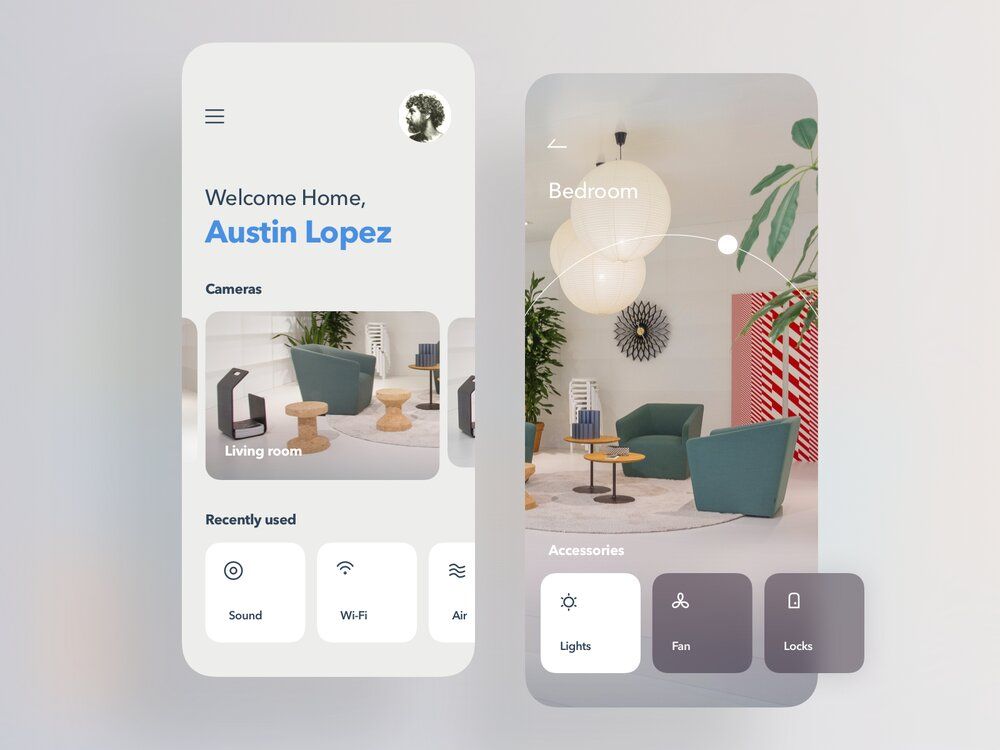
Smart home apps enhance convenience, security, and energy efficiency by enabling remote control of connected devices (image by White Label)
Examples of IoT Apps in Smart Homes
Here are examples of smart home apps:
- Philips Hue. A smart lighting system that lets users control brightness, color, and schedules via a mobile app, integrating with other smart home devices.
- AT&T Smart Home Manager App. A comprehensive app that allows AT&T Fiber customers to manage their home Wi-Fi network effortlessly. Users can monitor Internet-connected devices, optimize Wi-Fi performance, set up parental controls, and receive security alerts.
📌 For a detailed breakdown of expenses, read our article on the cost to build an app like AT&T Smart Home Manager to get insights into the factors influencing pricing.
The demand for IoT application development is skyrocketing across multiple industries, with businesses leveraging connected technology to optimize efficiency, enhance user experiences, and gain a competitive edge. Whether in healthcare, logistics, automotive, or smart homes, companies investing in smart apps set new standards for innovation and service delivery.
💰 What Affects IoT Application Development Costs?
When setting a budget to develop an IoT application, you should ensure that your budget aligns with your project’s needs.
On average, Internet of Things app development costs range from $35,500 to $60,000. While exact costs vary based on specific requirements, several key factors influence the overall development expenses:
1. Number & Complexity of Features. Advanced features like real-time tracking, predictive analytics, or AI-driven automation will increase costs.
2. Scope of the Device. The type of smart device and its capabilities (e.g., wearables, warehouse sensors, or smart home devices) affect development efforts.
3. Chosen Technology Stack. Selecting the right programming languages, frameworks, and cloud solutions can impact both costs and scalability.
4. Third-Party Services & Integrations. APIs, cloud storage, security protocols, and connectivity services (e.g., AWS IoT, Google Cloud IoT) add extra expenses.
5. Development Team's Hourly Rate. Costs vary depending on the team’s location, expertise, and collaboration model (in-house vs. outsourcing).
📌 For a detailed breakdown, check out our comprehensive guide on IoT application development costs.
💡 Takeaways
Building a successful Internet of Things application requires a strategic approach, strong security measures, and the right technology stack. Here are the key takeaways from this guide:
- Define clear objectives and scope. Ensure you have a well-defined use case, target audience, and key functionalities to develop an IoT application.
- Prioritize security from the start. Implement end-to-end encryption, secure authentication, and tamper-resistant hardware to protect user information.
- Ensure scalable data handling. Use real-time data streaming, cloud storage, and edge computing to manage large data volumes efficiently.
- Leverage IoT platforms for backend development. Platforms like AWS IoT, Google Cloud IoT, and Azure IoT Suite can speed up development and enhance scalability.
- Create an intuitive and responsive frontend. A user-friendly UI with clear data visualization improves user experience and engagement.
- Test rigorously before deployment. Conduct functional, security, and load testing to ensure reliability across different devices and conditions.
- Plan for long-term maintenance and scaling. Use containerization, monitoring tools, and OTA updates to optimize performance over time.
IoT application development is a rewarding but challenging process. Whether you’re just starting or looking to optimize an existing solution, our team is here to help.
Our clients say
![Stormotion client Alexander Wolff, CPO from [object Object]](/static/a16ba3c9580effc3ab9a68d115eadffe/b0e74/alex.png)
When I was working with Stormotion, I forgot they were an external agency. They put such effort into my product it might as well have been their own. I’ve never worked with such a client-focused company before.
Alexander Wolff, CPO
Sjut
Was it helpful?
Questions you may have
Take a look at how we solve challenges to meet project requirements
What is an IoT application, and how does it work?
An Internet of Things (IoT) application is software that connects smart devices via the Internet, enabling info collection, communication, and automation. It helps businesses improve efficiency and user experience by integrating sensors, cloud computing, and analytics.
What programming languages are commonly used to develop IoT applications?
The choice of programming language for IoT applications development depends on the component being developed. For backend and cloud development, Java and Python are popular choices as they enable data processing, analytics, and server-side operations. React Native, is widely used for building companion apps with cross-platform support for mobile and web applications.
What type of devices can be integrated into an IoT application?
Internet of Things apps can connect sensors, actuators, smart appliances, wearables, medical equipment, industrial equipment, and other connected hardware.
How do I choose the right IoT platform for my application?
Choosing the right IoT platform requires considering factors such as supported network protocols, cloud architecture flexibility, scalability, hardware support, security mechanisms, and integration capabilities with other systems.
What are some common challenges when developing IoT applications?
Common challenges include ensuring interoperability across diverse devices and systems, managing information security and privacy, achieving scalability, and navigating the complexities of developing and maintaining an interconnected ecosystem.
How can I ensure my IoT application is secure?
To ensure security, implement strong user authentication, data encryption, and access rights management while complying with standards like ISO 27001, SOC 2 Type 2, and IEC 62304 for healthcare-related apps. Additionally, use secure connections (HTTPS) and integrate security measures from the start of the development process.
How can I test my IoT application?
Testing an IoT application involves various types of testing, including security, performance, usability, compatibility, and scalability. Tools like Wireshark and mPulse can help facilitate this process.
What are some best practices for developing IoT applications?
Best practices for IoT application development include prioritizing user experience, implementing multi-layered security techniques, leveraging third-party SDKs and APIs for faster development, focusing on backend and API optimization, and integrating automated testing throughout the process.
How can I optimize the performance of my IoT application?
Performance optimization can be achieved through efficient resource usage at the device level, optimized info transmission, edge computing for processing data closer to the source, and scalable cloud services.
What resources are available to help me develop my IoT application?
IoT apps development frameworks like React Native and Flutter enable the creation of cross-platform mobile apps for connected devices. Cloud solutions such as AWS IoT, Google Cloud IoT, and Azure IoT Suite offer scalable infrastructure, built-in security, and analytics tools. Open-source platforms like KAA IoT provide customizable features for managing connected devices.
Read also



